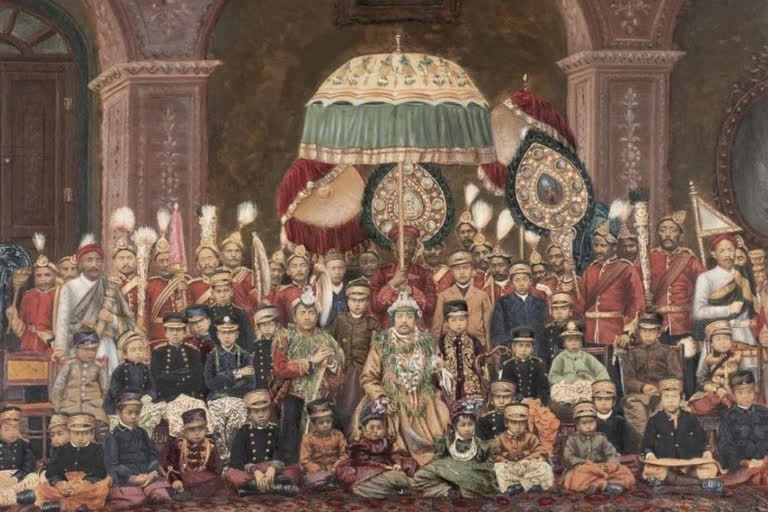Mussoorie (Uttarakhand): Go past the old Railway School in Jharipani village near Mussoorie, you stumble upon the ruins of a sprawling collection of grand buildings that have yawning gateways and balusters made of lime and mortar. These dilapidated ones bring back memories of the glory days of Fairlawn Palace and of Dev Shamsher Rana, an exiled member of the Nepali royalty, who made Mussoorie area their second home following discord in the royal family.
Fairlawn Palace was once home to Maharaja Dev Shamsher Jung Bahadur Rana, who served as Prime Minister of Nepal for only 144 days, till his brother Chandra Shamsher Rana deposed him in 1901. Perhaps far too ahead for his times, the liberal Dev Shamsher had abolished slavery, started a newspaper and established a college for women. When he escaped to Darjeeling, the British did not allow him to stay there for long as it was too temptingly close to the Nepalese border, instead they gave him two options: the first, land in Delhi (what was later to become Connaught Place) and the second, a place in Mussoorie.
Also Read: Queen Elizabeth II had Mussoorie connection, claims historian Gopal Bhardwaj
Choosing the latter, because Mussoorie was a hill-and-mountain country much like his native country left behind by Dev Shamsher. The site of Fairlawn was well seated on a ridge with splendid views, big garden and plentiful water. ‘The hill had to be leveled at enormous cost – the staggering sum of three lakh rupees!’ recalled Jagat Shumshere, one of Dev's sons. With a bit of help from the Irish Patrician Brothers of the nearby St. Georges’s College, Dev built a Nepalese style palace to settle down with his large family: twelve sons, four daughters and a host of concubines. ‘We must study the disastrous effect this sudden influx will have on the sanitation of the hill station,’ one harried official complained. The royal exiles had brought almost everything, including the famous Naulakha haar – a necklace made of multiple strings of pearls – taken from Nana Sahib when he sought refuge after the events of 1857. The necklace was brought carefully concealed in a bottle of mango pickle.
Dev Shamsher had sour relations with his brother Chandra all through his life. Of course, the estranged brothers, were fated to meet again in Calcutta, where the following exchange took place:
‘Your Highness,’ complained Chandra, ‘you escaped and tricked me of your person.’
‘Your Highness tricked me of my rightful kingdom,’ answered Dev in a tit-for-tat.
Writers have touched upon much of the Ranas' love of wine, women and song. Between the boozing and cruising, the exiles are reported to have played games of chess whiling their days away. In his fifties, Dev had a stroke and wrote to his brother: ‘I am growing old and am now a broken man. Pray grant that I may see my country once again before I die.’ But it was not to be. Bursting into tears, broken hearted on 20th February 1914, aged fifty-two, Dev Shamsher died ‘a mysterious death by his own gun.’
Also Read: India and Nepal to expedite Ramayana Circuit; foreign secretaries hold talks
Looking for material for my books, I approached Lt. Gen. R.K. Jasbir Singh (Retd), a former Commandant of National Defence Academy, for memories of his wife’s home (Fairlawn). He wrote: ‘Fairlawn was a magnificent structure embodying the best of Nepalese and European designs – extending all the way down to the main road to Dehradun. It needed a retinue of over a hundred people to tend to the place. In its heydays, everyone who was anyone paid a visit Fairlawn.
‘In the 1950s, Jagat Shumshere left Mussoorie for Nepalganj. He had been the life and soul of Fairlawn – with an impish (and somewhat bawdy) sense of humour, loving practical jokes of all sorts. Nothing could faze him and he was often called the Laughing Buddha. ‘I’m told in his later years he turned to yoga and became a strict vegetarian. Now that is saying something about a Nepalese! It will be nigh impossible finding one worth his salt who can do without meat (besides, wine and women!) ‘Mussoorie Rana’ is reputed to have more than made up for the loss of non-vegetarian food by fully indulging in the others, before he passed away in Kathmandu in 1957.’
Fairlawn was divided between the siblings. Its Madalsa House is a Tibetan nunnery, the main building a school and to the rear soars a pin-cushioned housing complex. Are the Ranas finally home? One wonders.



